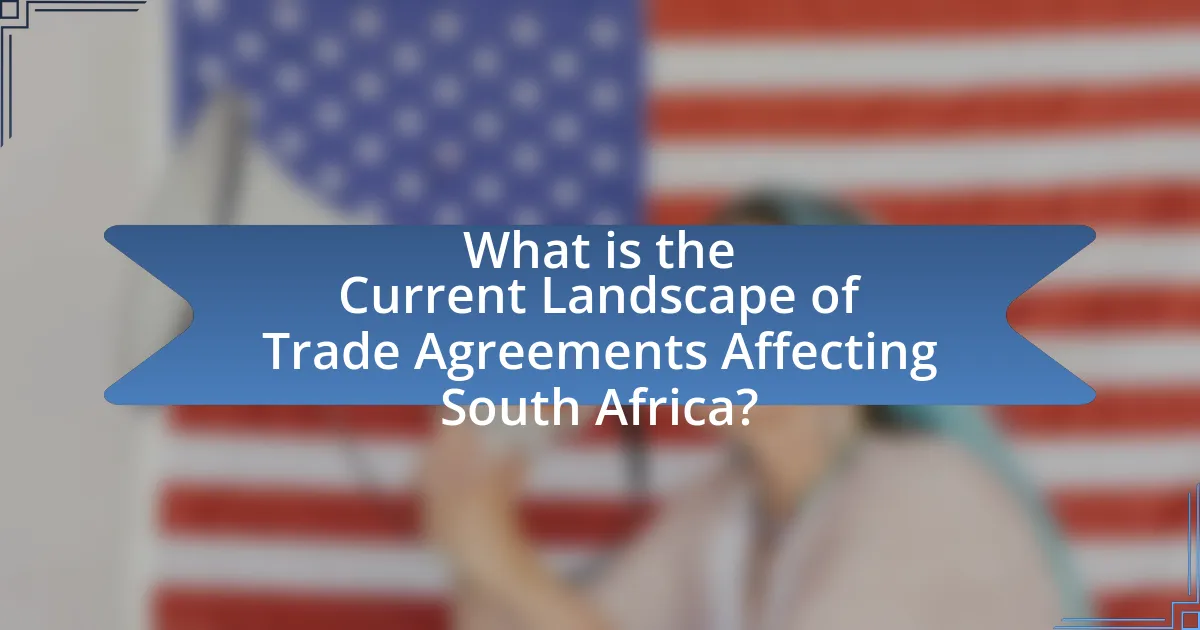Trade agreements are formal arrangements between countries that define the terms of trade, including tariffs and regulations, playing a vital role in economic policy by facilitating international trade and promoting economic growth. This article analyzes the impact of trade agreements on South African economic policy, highlighting key components such as tariff reductions, investment provisions, and dispute resolution mechanisms. It examines how these agreements influence national economies, trade balances, and domestic policies, while also addressing the historical context and current landscape of trade agreements affecting South Africa. Additionally, the article discusses the challenges South Africa faces in trade negotiations and offers strategies for optimizing the benefits of these agreements to enhance economic growth.

What are Trade Agreements and Their Importance in Economic Policy?
Trade agreements are formal arrangements between countries that outline the terms of trade, including tariffs, import quotas, and other trade regulations. These agreements are crucial in economic policy as they facilitate international trade, enhance market access, and promote economic growth by reducing trade barriers. For instance, the North American Free Trade Agreement (NAFTA), implemented in 1994, significantly increased trade among the U.S., Canada, and Mexico, demonstrating how trade agreements can lead to economic expansion and job creation. Additionally, trade agreements can influence domestic policies by encouraging countries to adopt regulations that align with international standards, thereby fostering a more competitive economic environment.
How do trade agreements influence national economies?
Trade agreements significantly influence national economies by facilitating increased trade flows, reducing tariffs, and enhancing market access. For instance, the North American Free Trade Agreement (NAFTA) led to a 20% increase in trade between the U.S., Canada, and Mexico from 1993 to 2000, demonstrating how such agreements can boost economic activity. Additionally, trade agreements often encourage foreign direct investment (FDI) by providing a stable and predictable environment for investors, which can lead to job creation and economic growth. The World Bank has reported that countries engaged in trade agreements tend to experience higher GDP growth rates compared to those that are not, highlighting the positive economic impact of these agreements.
What are the key components of trade agreements?
The key components of trade agreements include tariff reductions, trade in services, investment provisions, intellectual property rights, and dispute resolution mechanisms. Tariff reductions facilitate lower costs for imported goods, promoting trade between countries. Trade in services encompasses regulations that govern the exchange of services across borders, enhancing economic cooperation. Investment provisions protect foreign investments and encourage capital flow, while intellectual property rights safeguard innovations and creations, fostering creativity and economic growth. Dispute resolution mechanisms provide a structured process for resolving conflicts that may arise from the agreement, ensuring compliance and stability in trade relations. These components collectively aim to enhance economic integration and cooperation among participating nations.
How do trade agreements affect trade balances?
Trade agreements generally improve trade balances by reducing tariffs and trade barriers, which encourages exports and imports. For instance, the African Continental Free Trade Area (AfCFTA) aims to increase intra-African trade by eliminating tariffs on 90% of goods, thereby enhancing market access for South African products. This increased access can lead to a higher volume of exports, positively impacting the trade balance. Additionally, empirical studies, such as those conducted by the World Bank, indicate that countries engaging in trade agreements often experience a significant boost in trade flows, which can lead to improved trade balances over time.
Why are trade agreements particularly relevant for South Africa?
Trade agreements are particularly relevant for South Africa because they facilitate access to international markets, enhance economic growth, and promote foreign investment. South Africa’s economy is heavily reliant on exports, with trade agreements such as the African Continental Free Trade Area (AfCFTA) and the Southern African Development Community (SADC) enabling the country to expand its trade relationships and reduce tariffs. In 2020, South Africa’s exports to the African continent accounted for approximately 25% of total exports, highlighting the importance of regional trade agreements in boosting economic activity and integration.
What historical context shapes South Africa’s trade agreements?
South Africa’s trade agreements are shaped by its colonial history, apartheid legacy, and the transition to democracy. The colonial period established economic structures favoring European powers, while apartheid policies isolated South Africa from global trade networks, leading to sanctions and trade restrictions. Following the end of apartheid in 1994, South Africa sought to reintegrate into the global economy, resulting in trade agreements such as the African Growth and Opportunity Act (AGOA) and participation in the Southern African Development Community (SADC). These agreements reflect the country’s efforts to promote economic growth, attract foreign investment, and enhance regional cooperation, addressing historical inequalities and fostering development.
How do trade agreements align with South Africa’s economic goals?
Trade agreements align with South Africa’s economic goals by facilitating increased trade, attracting foreign investment, and promoting economic growth. These agreements, such as the African Continental Free Trade Area (AfCFTA) and various bilateral trade deals, aim to reduce tariffs and trade barriers, thereby enhancing market access for South African goods and services. For instance, the AfCFTA is projected to boost intra-African trade by 52% by 2022, which directly supports South Africa’s goal of expanding its export markets and diversifying its economy. Additionally, trade agreements often include provisions for technology transfer and capacity building, which further align with South Africa’s objectives of fostering innovation and improving competitiveness in key sectors.

What is the Current Landscape of Trade Agreements Affecting South Africa?
The current landscape of trade agreements affecting South Africa includes several key agreements that shape its economic interactions. South Africa is a member of the African Continental Free Trade Area (AfCFTA), which aims to create a single market for goods and services across the continent, potentially increasing intra-African trade by 52% by 2022. Additionally, South Africa has trade agreements with the European Union through the Trade, Development and Cooperation Agreement (TDCA), which facilitates trade and investment between the two regions. The Southern African Development Community (SADC) Free Trade Area also plays a significant role, allowing for reduced tariffs among member states. These agreements collectively influence South Africa’s economic policy by promoting trade diversification and enhancing regional integration.
Which trade agreements is South Africa currently a part of?
South Africa is currently a part of several trade agreements, including the African Continental Free Trade Area (AfCFTA), the Southern African Development Community (SADC) Free Trade Area, and the Economic Partnership Agreement (EPA) with the European Union. The AfCFTA, which came into effect in January 2021, aims to create a single continental market for goods and services, enhancing intra-African trade. The SADC Free Trade Area facilitates trade among member states in Southern Africa, while the EPA with the EU allows South Africa to export goods to European markets with reduced tariffs. These agreements are integral to South Africa’s economic policy, promoting trade diversification and regional integration.
What are the objectives of these trade agreements?
The objectives of trade agreements are to enhance economic cooperation, reduce trade barriers, and promote mutual benefits among participating countries. These agreements aim to facilitate trade by lowering tariffs, eliminating quotas, and establishing common standards, which can lead to increased market access and economic growth. For instance, the African Continental Free Trade Area (AfCFTA) aims to create a single market for goods and services across Africa, potentially boosting intra-African trade by 52.3% by 2022, according to the African Union.
How do these agreements compare with those of other countries?
South African trade agreements differ from those of other countries primarily in their focus on regional integration and development. While many countries prioritize bilateral or multilateral agreements aimed at reducing tariffs and increasing trade volume, South Africa’s agreements often emphasize economic cooperation within the African continent, as seen in the African Continental Free Trade Area (AfCFTA) established in 2019. This agreement aims to create a single market for goods and services across Africa, contrasting with trade agreements in regions like the European Union, which focus on deeper economic integration and regulatory alignment among member states. Additionally, South Africa’s agreements frequently incorporate provisions for sustainable development and social equity, reflecting its unique socio-economic context and priorities compared to countries that may prioritize purely economic gains.
What challenges does South Africa face in its trade agreements?
South Africa faces several challenges in its trade agreements, primarily including unequal bargaining power, trade imbalances, and regulatory barriers. Unequal bargaining power often results from larger economies dominating negotiations, which can lead to unfavorable terms for South Africa. For instance, trade agreements with the European Union have been criticized for favoring European exports while limiting South African access to those markets. Trade imbalances are evident in the significant deficits South Africa experiences with certain trading partners, impacting local industries and employment. Additionally, regulatory barriers, such as differing standards and compliance requirements, complicate trade processes and can hinder South African exports. These challenges collectively affect the country’s economic policy and its ability to leverage trade agreements for sustainable growth.
How do domestic policies impact the effectiveness of trade agreements?
Domestic policies significantly impact the effectiveness of trade agreements by shaping the regulatory environment and economic conditions under which these agreements operate. For instance, if a country implements protectionist domestic policies, such as tariffs or quotas, it can undermine the benefits of trade agreements designed to promote free trade. A study by the World Bank in 2020 highlighted that countries with consistent and transparent domestic policies are more likely to fully realize the economic benefits of trade agreements, as they create a stable environment for foreign investment and trade. In South Africa, the alignment of domestic policies with trade agreements, such as the African Continental Free Trade Area (AfCFTA), is crucial for maximizing economic growth and integration within the region.
What external factors influence South Africa’s trade agreements?
External factors that influence South Africa’s trade agreements include global economic conditions, geopolitical relationships, and international trade policies. Global economic conditions, such as fluctuations in commodity prices and economic growth rates in partner countries, directly affect South Africa’s trade dynamics. For instance, the country’s reliance on mineral exports makes it sensitive to changes in global demand and prices. Geopolitical relationships, including alliances and diplomatic ties with other nations, also shape trade negotiations and agreements. Additionally, international trade policies, such as tariffs and trade agreements established by organizations like the World Trade Organization, impact South Africa’s ability to negotiate favorable terms. These factors collectively determine the effectiveness and scope of South Africa’s trade agreements, influencing its economic policy and trade strategy.

How Do Trade Agreements Shape South African Economic Policy?
Trade agreements significantly shape South African economic policy by influencing trade flows, investment decisions, and regulatory frameworks. For instance, the African Continental Free Trade Area (AfCFTA) aims to reduce tariffs and increase intra-African trade, which encourages South Africa to align its policies with regional economic integration goals. Additionally, trade agreements often require South Africa to adopt specific standards and regulations, impacting sectors such as agriculture and manufacturing. The South African government has also utilized trade agreements to attract foreign direct investment, as seen in its participation in the Southern African Development Community (SADC) and the Economic Partnership Agreements (EPAs) with the European Union. These agreements facilitate market access and create a more favorable environment for investors, thereby shaping the overall economic landscape.
What specific economic policies are influenced by trade agreements?
Trade agreements specifically influence economic policies such as tariffs, import quotas, and trade regulations. These agreements often lead to the reduction or elimination of tariffs, which directly impacts the cost of imported goods and can stimulate trade by making foreign products more competitive in the domestic market. For instance, the African Continental Free Trade Area (AfCFTA) aims to reduce tariffs among member countries, thereby promoting intra-African trade and economic integration. Additionally, trade agreements can shape regulatory policies by establishing standards for product quality and safety, which can affect domestic industries and consumer protection laws. The World Trade Organization (WTO) agreements also exemplify how international trade rules can dictate national policies on subsidies and anti-dumping measures, further illustrating the significant influence of trade agreements on economic policy frameworks.
How do trade agreements affect tariffs and trade barriers?
Trade agreements reduce tariffs and trade barriers between participating countries. By establishing preferential trade terms, these agreements often lead to lower import duties and fewer restrictions on goods, which facilitates increased trade flows. For instance, the Southern African Development Community (SADC) Trade Protocol aims to eliminate tariffs on intra-regional trade, thereby promoting economic integration among member states. This reduction in tariffs can enhance competitiveness and lower prices for consumers, as evidenced by the increase in trade volume among SADC countries since the protocol’s implementation.
What role do trade agreements play in attracting foreign investment?
Trade agreements play a crucial role in attracting foreign investment by creating a stable and predictable environment for investors. These agreements typically reduce tariffs, eliminate trade barriers, and enhance market access, which lowers the cost of doing business for foreign companies. For instance, the African Continental Free Trade Area (AfCFTA) aims to boost intra-African trade by reducing tariffs on goods, thereby making it more appealing for foreign investors to enter the South African market. Additionally, trade agreements often include provisions that protect foreign investments, such as dispute resolution mechanisms, which further enhance investor confidence. According to the World Bank, countries with comprehensive trade agreements experience a 20% increase in foreign direct investment inflows compared to those without such agreements, highlighting their effectiveness in attracting investment.
How can South Africa optimize its trade agreements for economic growth?
South Africa can optimize its trade agreements for economic growth by enhancing regional integration and focusing on sectors with competitive advantages, such as agriculture and manufacturing. By actively participating in the African Continental Free Trade Area (AfCFTA), South Africa can increase market access for its goods, potentially boosting intra-African trade, which was valued at approximately $300 billion in 2020. Additionally, leveraging trade agreements to reduce tariffs and non-tariff barriers can stimulate exports, as evidenced by the 2019 Trade Policy Review by the World Trade Organization, which highlighted the positive impact of reduced trade barriers on economic performance.
What strategies can be implemented to enhance trade agreement benefits?
To enhance trade agreement benefits, countries can implement strategies such as improving regulatory coherence, increasing market access, and fostering collaboration between public and private sectors. Regulatory coherence ensures that standards and regulations are aligned, reducing trade barriers and facilitating smoother transactions. Increasing market access involves negotiating lower tariffs and eliminating quotas, which can lead to increased exports and imports, ultimately boosting economic growth. Collaboration between public and private sectors can enhance innovation and competitiveness, as businesses can better navigate trade agreements with government support. For instance, the African Continental Free Trade Area (AfCFTA) aims to create a single market for goods and services across Africa, which exemplifies how regional cooperation can enhance trade benefits by expanding market opportunities and reducing trade costs.
How can South Africa address the challenges posed by trade agreements?
South Africa can address the challenges posed by trade agreements by enhancing its domestic industries and improving trade negotiation strategies. Strengthening local manufacturing capabilities can reduce dependency on imports and increase competitiveness in global markets. For instance, the South African government has implemented initiatives like the Industrial Policy Action Plan (IPAP), which aims to boost local production and create jobs. Additionally, improving negotiation strategies can ensure that trade agreements are more favorable, as seen in the African Continental Free Trade Area (AfCFTA), which aims to increase intra-African trade and reduce tariffs. By focusing on these areas, South Africa can better navigate the complexities of trade agreements and leverage them for economic growth.
What best practices can South Africa adopt in managing trade agreements?
South Africa can adopt several best practices in managing trade agreements, including enhancing stakeholder engagement, ensuring transparency, and leveraging data analytics. Engaging stakeholders, such as businesses and civil society, fosters a collaborative environment that can lead to more effective trade policies. Transparency in negotiations and implementation builds trust and accountability, which is crucial for long-term success. Additionally, utilizing data analytics allows for informed decision-making by assessing the impacts of trade agreements on various sectors, thereby optimizing economic outcomes. These practices are supported by the South African government’s commitment to inclusive economic growth and sustainable development, as outlined in the National Development Plan.


